Using pH Strips to Predict the Timing of Foal Birth
Last week, we asked our readers:
Using pH strips to predict the timing of the foal – do they work, and what advice can you offer?
We’ve listed your advice in our EC web article below, and we also have a very useful article from Michigan State University following the comments, so keep scrolling!
Hailey Torgerson
I use the pH up until it is near 6.0 and then use the foal watch calcium kit which is even more exact but the pH is great for narrowing it down! I have a lot of mares that foal once it hits 6.0, some wait a couple days after.
Good Better Best
Foal Watch! It’s the bomb!!
Patty Goodwin
I have used the ph strips for years. They are a good tool for predicting birth within 24 hours. I also use Foal Watch. Worth the investment!
Missy Neill
Love them! Very accurate!
Running Springs QH & Cattle Co.
It’s a tool. Along with Watching for the milk to turn white – also using calcium strips. It’s usually pretty accurate. But I’ve had mares who test within 12-24 house that have waited 4 more days.
Ann Luebbers
I’m old school. I have the strips use then once in a while ONLY when there is NO wax but a bead of milk present. My reason is because once you knock off that wax (plug) they have the chance of dripping all that sticky gold colostrum out! Takes a few days but then you have more of a problem. That’s another post.
Caleigh Anderson
I’m an equine vet tech who also helps to manages the foaling side of our repro division. pH strips are a great start but Ca strips, Ca titret testing, and monitoring changes in the mare are the most accurate! We have our foaling predicted down to a 48-hour window!
Billy Griffith
Absolutely works! Each time I’ve tested pH and got a 6.0 we had a foal in under 12 hours. I just use a quality pH pool testing strip.
Justin R Wheeler
Yes ph tests absolutely help! Most mares get down close to 6 on the scale before they are ready to foal but not all do. The Foal Watch calcium tests are the best. They require more time and more steps in the process but you know when a mare is going to foal within 24 hours. We have used them for the last 6 years and haven’t lost a night of sleep!
Travis Heidtman
Yes, they work! If Ph is under 6, you better be on foal watch! Milk will be super sticky as well.
Inggie Ohls
Have been breeding horses for years and they have never worked for me. Not once.
Claire Marcell
Foal watch calcium tests all the way! They get me within 24 hrs every time. So much more accurate than pH strips.
Cecily Zuidema
Absolutely help narrow down the window!
Heather Jackson Miller
I only wish I knew about this all those years I was on foal watch…so much sleep could have been saved!
Foaling indicators: Mammary fluid changes
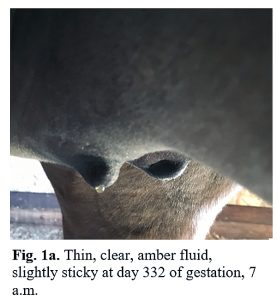 For many, the foaling season brings eager anticipation, hopeful expectations, maybe a little anxiety and, more than likely, a sleepless night or two. Michigan State University Extension has some tips for minimizing those sleepless nights.
For many, the foaling season brings eager anticipation, hopeful expectations, maybe a little anxiety and, more than likely, a sleepless night or two. Michigan State University Extension has some tips for minimizing those sleepless nights.
The average length of gestation for a mare ranges from 320 to 362 days, with a normal gestation range of 335 to 342 days. For most mares, foaling is uncomplicated and everything progresses smoothly. But, in the rare instances when there are complications, early recognition and intervention are needed to give the best chance of a successful foaling. For that reason, it is important to have someone present to observe all stages of the foaling process.
There are a variety of clinical signs that develop as a mare approaches foaling. Many of the mare’s physical changes occur a month or so before foaling and are initially subtle. However, as the day of foaling nears, the changes become more discernible. The first distinguishable change, which is 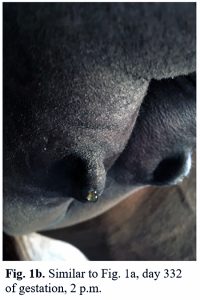 usually seen in the last month of pregnancy, is mammary gland development. Some mares will develop edema around the area of the udder before the gland itself becomes enlarged and fills with fluid.
usually seen in the last month of pregnancy, is mammary gland development. Some mares will develop edema around the area of the udder before the gland itself becomes enlarged and fills with fluid.
Once the mare begins developing an udder, it is recommended to monitor changes in mammary development daily. The color and consistency of mammary secretions is a good indicator to predict time of foaling. Researchers have developed several commercial foal prediction tests that measure calcium levels, pH levels or electrolyte levels in mammary secretions. Predict-A-Foal by Breeder’s Choice, FoalingWatch K-1700 by FoalWatch, Foaling Predictor kit by FoalGuard, and Foal Indicator Strips by FullBucket are all options available on the market. Initially the fullness of the udder may appear to fluctuate during the day, but as parturition nears, the udder will remain distended and the teats, once flat, will start to swell and tip slightly outward as they fill with fluid.
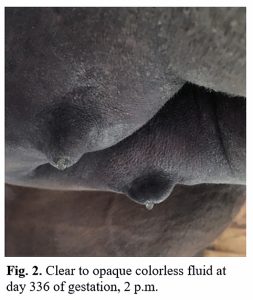 However, simple and careful observation of the mammary secretions can also be a reliable foaling indicator if you understand what you are observing. The reliability and success of any method utilizing mammary secretions to predict foaling is enhanced when samples are taken around the same time at least once or twice a day starting 10 to 14 days before the expected foaling date. Since most mares foal at night, the most accurate results are assessed from samples evaluated in the late afternoon or early evening (evening feed time is a common recommendation).
However, simple and careful observation of the mammary secretions can also be a reliable foaling indicator if you understand what you are observing. The reliability and success of any method utilizing mammary secretions to predict foaling is enhanced when samples are taken around the same time at least once or twice a day starting 10 to 14 days before the expected foaling date. Since most mares foal at night, the most accurate results are assessed from samples evaluated in the late afternoon or early evening (evening feed time is a common recommendation).
To obtain a sample of fluid, gently squeeze the base of the teat/nipple between the index finger and thumb and then pull towards the tip of the teat. To monitor changes by simple observation, first, strip a small amount of fluid from each teat (three to four big drops) to clear out old fluid from the teat canals. Next, strip out a fluid sample and examine it against a dark background. This can be easily accomplished by letting a drop hang from the teat using the darkness of the udder for contrast.
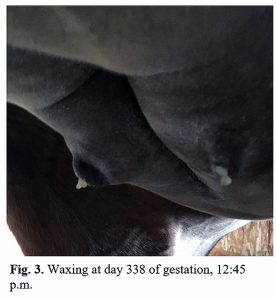 While the exact timeline of changes in mammary secretions is different for every mare, once fluid can be stripped from each teat, the changes in both color and secretion makeup will typically occur in a similar sequence. Initially the fluid will be clear, amber colored and the consistency will be fairly thin and slightly sticky. (See figures 1a and 1b.) Then the mammary secretions will begin to transition from a clear to opaque, colorless appearance (See figure two.)
While the exact timeline of changes in mammary secretions is different for every mare, once fluid can be stripped from each teat, the changes in both color and secretion makeup will typically occur in a similar sequence. Initially the fluid will be clear, amber colored and the consistency will be fairly thin and slightly sticky. (See figures 1a and 1b.) Then the mammary secretions will begin to transition from a clear to opaque, colorless appearance (See figure two.)
As time of foaling becomes more imminent, some mares will develop a yellowish, waxy substance at the end of their teats, often referred to as waxing. This substance is an accumulation of dried colostrum. Finally, the mammary fluid will become milky white in color and will be sticky from the colostrum. At this stage, foaling usually occurs within 24 to 48 hours. (See figures three and four.)
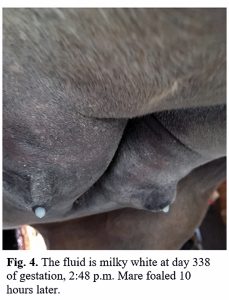 Utilizing the practice of daily inspections of mammary secretions can be a reliable method for predicting time of foaling, especially when combined with other physical signs of approaching parturition. While it’s critical to remember that every mare is different, each mare usually has a consistent foaling pattern, showing similar signs on similar timelines from year to year. Keeping detailed records is essential for optimizing the chance of being present at the time of delivery.
Utilizing the practice of daily inspections of mammary secretions can be a reliable method for predicting time of foaling, especially when combined with other physical signs of approaching parturition. While it’s critical to remember that every mare is different, each mare usually has a consistent foaling pattern, showing similar signs on similar timelines from year to year. Keeping detailed records is essential for optimizing the chance of being present at the time of delivery.
All photos used in this article are from the same mare and taken by Marci Charest, Michigan State University Extension.












